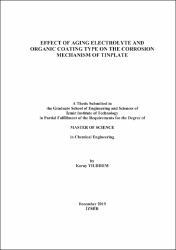Please use this identifier to cite or link to this item:
https://hdl.handle.net/11147/9623Full metadata record
| DC Field | Value | Language |
|---|---|---|
| dc.contributor.advisor | Kızılkaya, Ali Can | |
| dc.contributor.advisor | Çağlar, Başar | |
| dc.contributor.author | Yıldırım, Koray | - |
| dc.date.accessioned | 2020-08-24T07:52:23Z | |
| dc.date.available | 2020-08-24T07:52:23Z | |
| dc.date.issued | 2019-12 | en_US |
| dc.identifier.citation | Yıldırım, K. (2019). Effect of aging electrolyte and organic coating type on the corrosion mechanism of tinplate. Unpublished master's thesis, İzmir Institute of Technology, İzmir, Turkey | en_US |
| dc.identifier.uri | https://hdl.handle.net/11147/9623 | |
| dc.description | Thesis (Master)--Izmir Institute of Technology, Chemical Engineering, Izmir, 2019 | en_US |
| dc.description | Includes bibliographical references (leaves: 95-99) | en_US |
| dc.description | Text in English; Abstract: Turkish and English | en_US |
| dc.description.abstract | Market share of the can coating industry was 2 billion dollars in 2018 globally. A large portion of this market is focused on protecting valuable goods such as foods and cosmetics. Recent bans on the Bisphenol A(BPA) created a BPA-free coating demand due to the high portion of BPA based coatings in the industry such as epoxy. A conventional epoxy based (EP) can coating was compared with a new design of BPAfree polyester coating(PE). Atomic Force Microscopy(AFM), Scanning Electron Microscopy(SEM), Electron Dispersive Spectroscopy(EDX), Electrochemical Impedance Spectroscopy(EIS), Direct Current(DC) Polarization were used to investigate degradation. Industrial and model tinplate samples are compared with surface investigation methods. AFM results indicate the surface composition difference. To investigate bare tinplate corrosion, a mixture of acidic electrolyte was prepared and compared with other conventional aging electrolytes, containing mono acids. The electrolyte prepared from mixed acids was found to have the highest detinning abilities. Therefore, coated samples were aged with this mixed acid solution electrolyte. EIS results indicated that the type of electrolyte alters the corrosion mechanism, indicated by the observance of different time constants at different time scales. During immersion tests, EP based coatings showed better corrosion resistance as shown by higher impedance at low frequency, higher coating resistance and lower capacitance values. However, after sterilization, polyester coated samples showed better corrosion protective abilities (indicated by lower amount of corrosion products and higher impedance values) compared to the epoxy sample even though AFM measurements indicated that it had larger pore sizes after aging compared to epoxy sample. These results are attributed to the larger electrochemical area and higher diffusion properties of EP coatings, obtained after modelling of EIS data. | en_US |
| dc.description.abstract | Dünya genelinde metal ambalaj kaplamalarının pazar payı, 2018 yılında 2 milyar olarak raporlanmıştır. Bu pazarın büyük bir kısmı gıda ve kozmetik gibi değerli ürünlerin korunmasına odaklanmaktadır. Kullanılan kaplamaların büyük bir kısmı Bisfenol A (BPA) ile üretilen epoksi bazlı reçineler içermektedir. BPA ile ilgili geçtiğimiz yıllarda getirilen yasal kısıtlamalar, BPA içermeyen kaplamalara yönelik yeni bir talep yaratmıştır. Bu tezde, epoksi (EP) ve polyester bazlı (PE) reçinelerle üretilen iki farklı kaplama karşılaştırılmıştır. Atomik Kuvvet Mikroskobu (AFM), Taramalı Elektron Mikroskobu (SEM), Elektron Dispersif Spektroskopisi (EDX), Elektrokimyasal Empedans Spektroskopisi (EIS) ve DC Polarizasyon testleri, kaplamaların bozunma düzeyini incelemek için kullanılmıştır. Endüstriyel ve model kalay kaplı çelik(tinplate) numuneleri, yapılan yüzey analizleri ile karşılaştırılmıştır. Alınan AFM sonuçları, yüzey kompozisyonunda farklılıklar olduğunu göstermektedir. Kaplanmamış tinplate korozyonu incelemek için, asidik bir elektrolit, endüstride sık kullanılan mono asit çözeltileri ile karşılaştırılmıştır. En yüksek kalay çözme hızı, karışık asitlerden hazırlanan elektrolit ile gözlemlenmiştir. Bu nedenle, kaplanmış yüzeyler bu karışık asit çözeltisi ile yaşlandırılmıştır. EIS sonuçları, elektrolit tipinin, korozyon mekanizmasını etkilediğini göstermektedir. Elektrolitte bekletme sırasında, EP numunelerinde, düşük frekansta daha yüksek empedans, daha yüksek kaplama direnci ve düşük kapasitans değerleri gözlemlenmiştir. Sterilizasyondan sonra gerçekleştirilen AFM ölçümleri, PE’in yüzeyinde EP’ye göre daha büyük porlar oluştuğunu göstermektedir. Buna rağmen EP’ye kıyasla daha iyi korozyon koruyucu özellikler (daha düşük korozyon ürünleri ve daha yüksek empedans değerleri) gözlemlenmiştir. EIS verilerinin modellenmesinden sonra elde edilen bu sonuçlar EP sisteminin, daha geniş elektrokimyasal aktif alana ve düşük difüzyon direncine atfedilmiştir. | en_US |
| dc.format.extent | xiv, 105 leaves | |
| dc.language.iso | en | en_US |
| dc.publisher | Izmir Institute of Technology | en_US |
| dc.rights | info:eu-repo/semantics/openAccess | en_US |
| dc.subject | Tinplate | en_US |
| dc.subject | Can coatings | en_US |
| dc.subject | Electrochemical Impedance Spectroscopy | en_US |
| dc.subject | Bisphenol | en_US |
| dc.title | Effect of aging electrolyte and organic coating type on the corrosion mechanism of tinplate | en_US |
| dc.title.alternative | Yaşlandırma solüsyonu ve organik kaplama tipinin kalay kaplı çelik korozyonu üstüne etkisi | en_US |
| dc.type | Master Thesis | en_US |
| dc.institutionauthor | Yıldırım, Koray | - |
| dc.department | Thesis (Master)--İzmir Institute of Technology, Chemical Engineering | en_US |
| dc.relation.publicationcategory | Tez | en_US |
| item.languageiso639-1 | en | - |
| item.fulltext | With Fulltext | - |
| item.openairecristype | http://purl.org/coar/resource_type/c_18cf | - |
| item.openairetype | Master Thesis | - |
| item.grantfulltext | open | - |
| item.cerifentitytype | Publications | - |
| Appears in Collections: | Master Degree / Yüksek Lisans Tezleri | |
Files in This Item:
| File | Description | Size | Format | |
|---|---|---|---|---|
| 10231795.pdf | MasterThesis | 21.81 MB | Adobe PDF |  View/Open |
CORE Recommender
Page view(s)
226
checked on Jul 22, 2024
Download(s)
684
checked on Jul 22, 2024
Google ScholarTM
Check
Items in GCRIS Repository are protected by copyright, with all rights reserved, unless otherwise indicated.